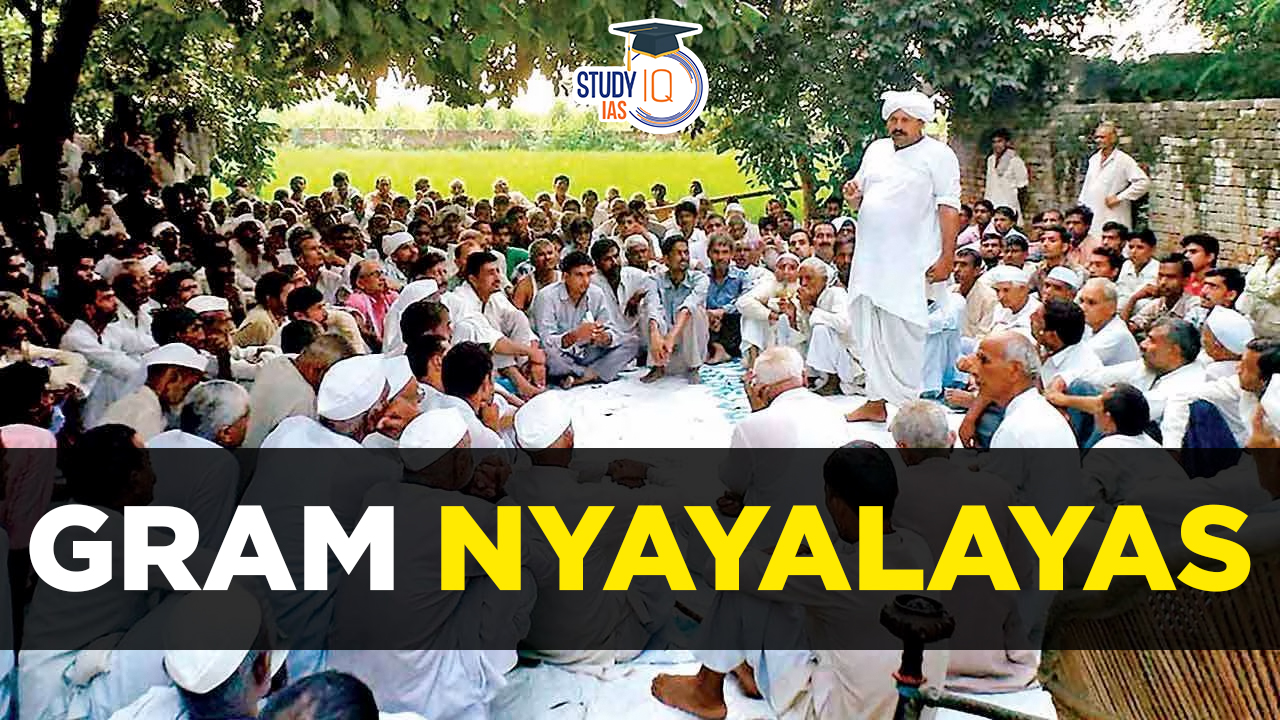Table of Contents
Gram Nyayalayas
Gram Nyayalayas are village courts in rural areas that give citizens of India instant access to the court system. The Indian Constitution’s Article 39-A requires that those in need and the weaker segments of society receive free legal representation. Gram Nyayalayas, which is covered in this article, is covered in the Indian Polity and Governance of UPSC Syllabus. Students can also go for UPSC Mock Test to get more accuracy in their preparations.
Gram Nyayalayas History
In its 114th Report, the Law Commission of India proposed changing from the elected Nyaya Panchayat system to a more “participatory justice” approach using Gram Nyayalayas. They suggested creating a three-member panel with a presiding judicial officer chosen from state judges and two lay-judges selected based on recommendations from the District Magistrate and District and Sessions Judge.
The inclusion of a judicial officer allowed the Commission to suggest expanding the criminal jurisdiction of these courts, without limiting them by monetary value. The aim was to combine the strengths of the traditional panchayat system with the modern judicial system.
Some provisions in the Act are based on the 114th Report, and Article 39A of the Indian Constitution, which provides free legal aid to the poor and vulnerable, and supports the establishment of affordable gram nyayalayas to ensure justice is accessible to all.
Gram Nyayalayas Functions
Its goal is to provide justice to those who are destitute and at their door. It aspires to establish Gram Nyayalayas in rural areas to offer swift, reasonably priced, and significant justice to the people of rural areas. According to Article 39A of the constitution, the state is required to ensure that the functioning of the legal system promotes justice on the basis of equal opportunity and shall provide free legal aid to ensure that no citizen is denied the opportunity to obtain justice due to their financial situation or other disabilities.
By streamlining the procedural regulations and introducing several options for alternative conflict resolution, like arbitration, conciliation, and mediation, it seeks to strengthen the court system. Generally speaking, the Gram Nyayalaya statute of 2008 is founded on the recommendations of the law commission.
Gram Nyayalayas Features
The Gram Nyayalayas shall be the first-class judicial magistrate court, and the state government shall appoint the court’s presiding officer (Nyayadhikari) after consulting with the High Court. Every intermediate level and panchayat will have a Gram Nyayalaya. The Gram Nyayalaya will be a travelling court that has both civil and criminal jurisdiction.
The headquarters of the intermediate panchayat will house the Gram Nyayalayas’ office; they will travel to the villages to do business and work there. Criminal trials as well as civil lawsuits, claims, and disputes are tried by the Gram Nyayalaya. The Gram Nyayalaya will exercise civil court authority with few adjustments and will adhere to the act’s specific procedure.
The Gram Nyayalaya will use the conciliation that will be designated for this purpose to try to mediate the disputes as much as feasible by bringing the parties to conciliation. The Gram Nyayalaya will follow natural justice principles and be bound by any rules issued by the High court.
An appeal must be made to the Court of Session in criminal cases, and it must be heard and decided within six months of the appeal being filed. In civil cases, the District Court is the proper venue for appeal, which must be filed and heard within six months after the appeal’s filing date. Anyone accused of a crime has the option to request a plea deal.
Gram Nyayalayas Act 2008
Gram Nyayalayas are intended to provide low-cost justice to residents of rural areas at their doorsteps. Gram Nyayalayas will be set up for each intermediate Panchayat or for a group of nearby Panchayats. They will be located at the headquarters of the intermediate Panchayat.
These courts will handle criminal cases, civil suits, and disputes listed in the Act’s First and Second Schedules. The Nyayadhikari will regularly visit villages to hear cases outside of the headquarters. They must follow a simplified procedure for criminal trials.
The Gram Nyayalaya shall not be bound by the rules of evidence provided in the Indian Evidence Act, 1872, but shall be guided by the principles of natural justice, subject to any rule made by the High Court. Disputes are to be settled as much as possible by bringing about conciliation between the parties, and for this purpose, the Gram Nyayalayas will use the conciliators to be appointed for this purpose.
Establishment of Gram Nyayalayas
Section 3 of the Gram Nyayalayas Act, 2008 allows state governments to set up gram nyayalayas in every intermediate Panchayat or in groups of nearby Panchayats, after consulting the High Court. States can also change the boundaries of these courts as needed. According to Section 4, the headquarters of a gram nyayalaya will be in the respective Panchayat or another designated location.
Composition of the Gram Nyayalayas
Section 5 outlines the appointment of the Nyayadhikari, the presiding officer of the rural courts, by the state government after discussing with the High Court. Section 6 requires the Nyayadhikari to meet the qualifications of a First Class Judicial Magistrate and ensures representation for marginalized groups, women, and Scheduled Tribes and Castes. The salary of the Nyayadhikari, as per Section 7, is the same as that of a First Class Judicial Magistrate.
Jurisdiction of the Gram Nyayalayas
The territorial jurisdiction of gram nyayalayas is set by state governments. These courts can operate as mobile courts in their specified areas after informing the local community. According to Section 11, gram nyayalayas have the authority to handle both criminal and civil matters. They can also accept certain types of evidence not usually allowed under the Indian Evidence Act, as stated in Section 30.
Procedure to be Followed Under the Act
The Gram Nyayalayas Act, 2008 states that the Code of Criminal Procedure, 1973 applies to criminal cases. However, cases will be resolved quickly using a simplified process unless the Nyayadhikari decides otherwise. For civil matters, the procedure differs from the Code of Civil Procedure, allowing the Nyayalaya to use its discretion to ensure quicker justice, as outlined in Section 24(6). Thus, the procedural rules are both similar to and different from existing criminal and civil codes.
Gram Nyayalayas Advantages
The Gram Nyayalayas, which are a component of the judicial reforms, are regarded as a important step in eliminating backlogs. Once Gram Nyayalayas are completely operational across the country, people would not have to use the expensive and time-consuming lower or higher courts.
Gram Nyayalayas are intended to handle new litigation that will be settled within six months and will cut the number of cases pending in subordinate courts by around half. It works to ensure that no citizen’s access to justice is restricted because of social, economic, or other limitations.
Gram Nyayalayas Disadvantages
The mobile rural courts, or gram nyayalayas, have some problems that need fixing at both the law and administration levels:
- Delayed Justice: These courts were meant to speed up justice and reduce the workload of higher courts. However, many appeals against their decisions still keep district courts busy with pending cases.
- Low Case Resolution: Very few cases have been resolved by gram nyayalayas, showing a lack of trust in these courts among the people.
- Lack of Official Posts: There is no regular staff for the Nyayadhikari position, which should be equivalent to a First Class Magistrate, indicating a need for bureaucratic reform.
- Confusion Over Jurisdiction: The presence of other dispute resolution options, like lok adalats and tribunals, creates confusion about the role of gram nyayalayas.
- Inaccessible Locations: Some gram nyayalayas are in urban areas or places that are not helpful for villagers.
- Lack of Awareness: Many rural litigants are unaware of gram nyayalayas, and there haven’t been enough awareness campaigns to inform them about these courts.
Conclusion
The establishment of gram nyayalayas is a significant step in improving the Indian judiciary and making it more accessible to those who struggle with its complexity. While they resemble the formal court system, gram nyayalayas also reflect local traditions and customs. This initiative shows the government’s commitment to Mahatma Gandhi’s ideals and his support for a homegrown approach to dispute resolution.
Gram Nyayalayas UPSC
The Gram Nyayalaya Act’s preamble promises that no one would be denied access to justice because of a disability and sees citizens having access to justice at their doorstep. Therefore, the effectiveness of these institutions should be evaluated not only in terms of the number of courts that have been established in various states, but also in terms of their capacity to assist the most vulnerable members of society and their contribution to the overall decline in the number of cases that are pending. Students can read all the details related to UPSC by visiting the official website of StudyIQ UPSC Online Coaching.


 SLAPP Suits: Meaning, Examples, Impact o...
SLAPP Suits: Meaning, Examples, Impact o...
 Finance Commission of India, Articles an...
Finance Commission of India, Articles an...
 High Number of Pending Cases in Supreme ...
High Number of Pending Cases in Supreme ...

























